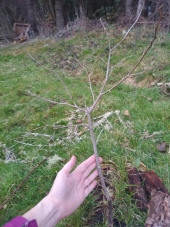
 9
9











 6
6




Other people may reject you but if you lie in the forest floor for long enough the moss and fungi will accept you as one of their own!
 4
4




This is all just my opinion based on a flawed memory

 8
8




Striving to grow things as naturally, simply, and cheaply as possible! 
My YouTube channel
 2
2




Visit Redhawk's soil series: https://permies.com/wiki/redhawk-soil
How permies.com works: https://permies.com/wiki/34193/permies-works-links-threads

 9
9




Steve Thorn wrote:My Pakistan and another less cold hardy mulberry have died back previously.
Pruning them seems to increase their cold susceptibility. Since I stopped pruning them they barely have any dieback now.
QuickBooks set up and Bookkeeping for Small Businesses and Farms - jocelyncampbell.com
 9
9




 5
5




Maybe Life is always like being on a trapeze or a tightrope at the circus...
 5
5




Ben Zumeta wrote:All 21 of my mulberries look very unhappy this spring. Either they have yet to leaf out, or what leafed out early died back in frost and hail. This is in contrast with most other species, (i.e. all 28 cherries look good). We have some difficult rocky serpentine clay soil, but I was told by a neighbor cherries seem to like it here, and alas they do. I would not have thought mulberries would be the thing to struggle given their supposed wide-ranging soil tolerances, but they’ve done the worst among the 600+ trees of dozens of species that I’ve planted so far here.
$10.00 is a donation. $1,000 is an investment, $1,000,000 is a purchase.
 5
5










 6
6




QuickBooks set up and Bookkeeping for Small Businesses and Farms - jocelyncampbell.com
 7
7

















 5
5




QuickBooks set up and Bookkeeping for Small Businesses and Farms - jocelyncampbell.com
 4
4




r ranson wrote:Thinking about last year. I did the usual harvesting of branches in the first half of the summer. But then I did a bit of a trim in Augest. The tree that got the most trimming is doing the worse.
So maybe the key is not to cut the branches after Augest?
Cutting back the dead wood yesterday, I noticed that one tree has a lot of orange dots (mould or fungus?) on the dead branches. But it's not on the other trees.
You should never forget that every creature has its purpose in the cycle of nature and can also be very important to humans. Sepp Holzer's Permaculture
 3
3




 2
2




I have heard about several places in the USA where Mulberries are pretty much considered a pest. Alas, that is not true of the Pacific Northwest, where both I, r ranson, and I think Jocelyn might describe her location as PNW as well.I can shave these stumps bare repeatedly, but they just won't die.
Visit Redhawk's soil series: https://permies.com/wiki/redhawk-soil
How permies.com works: https://permies.com/wiki/34193/permies-works-links-threads
 5
5




 2
2




 2
2




$10.00 is a donation. $1,000 is an investment, $1,000,000 is a purchase.

|
Did you just should on me? You should read this tiny ad:
2024 Permaculture Adventure Bundle
https://permies.com/w/bundle
|




